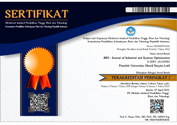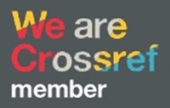ANALISIS KESELAMATAN DAN KESEHATAN KERJA DENGAN PENDEKATAN HAZARD IDENTIFICATION RISK ASSESSMENT AND FAULT TREE ANALYSIS PADA PT. WGI
DOI:
https://doi.org/10.51804/jiso.v5i1.10-17Keywords:
Analisa kecelakaan dan kesehatan kerja, HIRA, FTA, PT.WGIAbstract
PT.WGI merupakan perusahaan manufaktur yang memproduksi sepatu boots dan safety. Namun sangat disayangkan penerapan K3 pada PT.WGI belum berjalan secara optimal. Hal ini mengakibatkan beberapa kecelakaan kerja serta serta sangat mengganggu kersehatan pekerja pada PT.WGI. pengolahan data pada penelitian ini menggunakan metode HIRA kemudian hasil yang diketahui akan diolah kembali melalui FTA (Fault Tree AnalysisI). Dari hasil penelitian diperoleh 12 sumber bahaya kecelakaan kerja yang terjadi pada PT.WGI pada tahun 2018-2020. Dari 12 sumber kecelakaan berbeda dimana terdapat 2 kecelakaan yang tergolong kriteria risiko exreme antara lain tertabrak forklift dan tertabrak mover. Sedangkan untuk kecelakaan risiko tinggi terdapat 4 kecelakaan antara lain pekerja terjepit, tangan pekerja tertimpa matras, tangan pekerja melepuh, pekerja tersengat. Sedangkan untuk kategori tingkat risiko sedang terdapat 4 kecelakan kerja antara lain jari terjepit, gangguan pernafasan, tertimpa rak sepatu, terbentur bahan rein. Kecelakaan dan untuk kategori risiko rendah terdapat 2 kasus. Untuk penerapan FTA dilakukan untuk menentukan factor yang mengakibatkan kecelakaan kerja serta memberikan perbaikan untuk mengurangi kecelakaan kerja pada PT.WGI.
ABSTRACT
PT. WGI is a manufacturing company that produces boots and safety shoes. However, it is unfortunate that the implementation of K3 at PT. WGI has not run optimally. This resulted in several work accidents and greatly disrupted the health of workers at PT. WGI. data processing in this study using the HIRA method then the known results will be reprocessed through FTA (Fault Tree Analysis I). From the results of the study, there were 12 sources of work accident hazards that occurred at PT. WGI in 2018-2020. From 12 different accident sources, there were 2 accidents classified as extreme risk criteria, including being hit by a forklift and being hit by a mover. Meanwhile, for high-risk accidents, there were 4 accidents, including squeezing the worker, the worker's hand being hit by the mat, the worker's hand being scalded, and the worker being stung. Meanwhile, for the medium risk category, there are 4 work accidents, including pinched fingers, respiratory problems, falling on a shoe rack, hitting rein material. Accidents and for the low risk category there are 2 cases. For the application of the FTA, it is carried out to determine the factors that cause work accidents and provide improvements to reduce work accidents at PT. WGI.
References
Agustinus, S., Nugroho, A., & Cahyono, A. D. (2017). Analisis risiko teknologi informasi menggunakan ISO 31000 pada program HRMS. Jurnal RESTI (Rekayasa Sistem Dan Teknologi Informasi), 1(3), 250–258.
Ariko, M. F. (2019). Pengaruh Disiplin Kerja, Kompetensi, Serta Keselamatan Dan Kesehatan Kerja Terhadap Kinerja Karyawan PT. Sucofindo (Persero) Cabang Palembang. Jurnal Ilmu Manajemen, 8(1), 73–84.
Efendi, A., Nugroho, Y. S., & Fahmi, M. (2020). ANALISIS HIRA ASPEK KESELAMATAN DAN KESEHATAN KERJA (K3) DI LABORATORIUM MOTOR BAKAR POLITEKNIK NEGERI SUBANG. Jurnal Mesin Nusantara, 3(1), 17–28.
Gempur, S. (2004). Manajemen Keselamatan dan Kesehatan Kerja. Jakarta: Prestasi Pustaka.
Hasibuan, A., Purba, B., Marzuki, I., Mahyuddin, M., Sianturi, E., Armus, R., Gusty, S., Chaerul, M., Sitorus, E., & Khariri, K. (2020). Teknik Keselamatan dan Kesehatan Kerja. Yayasan Kita Menulis.
Khamid, A., Mulyadi, Y., & Mukhtasor, M. (2019). Analisa risiko keselamatan dan kesehatan kerja (K3) terhadap kecelakaan kerja serta lingkungan dengan menggunakan metode Hazard and Operability Study (HAZOP) pada proses scrapping kapal. Jurnal Teknik ITS, 7(2), G138–G143.
Sahid, M. N., & Eliska, A. D. (2019). Manajemen Bahaya Dan Risiko Pada Pekerja Gondola Proyek Apartemen Menara One (Studi Kasus: Menara One Kartasura, Sukoharjo, Jawa Tengah). Neo Teknika, 5(1).
Downloads
Published
Issue
Section
License
With the receipt of the article by JISO Editorial Board and the decision to be published, the copyright regarding the article will be transferred to JISO. The copyright transfer form can be downloaded here.
JISO has the right to multiply and distribute the article and every author is not allowed to publish the same article that was published in this journal.
JISO is licensed under a Creative Commons Attribution-ShareAlike 4.0 International License.
Under the following terms:
Attribution — You must give appropriate credit, provide a link to the license, and indicate if changes were made. You may do so in any reasonable manner, but not in any way that suggests the licensor endorses you or your use.
ShareAlike — If you remix, transform, or build upon the material, you must distribute your contributions under the same license as the original.














